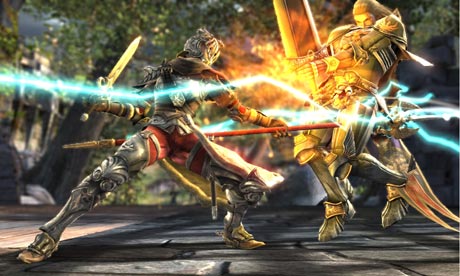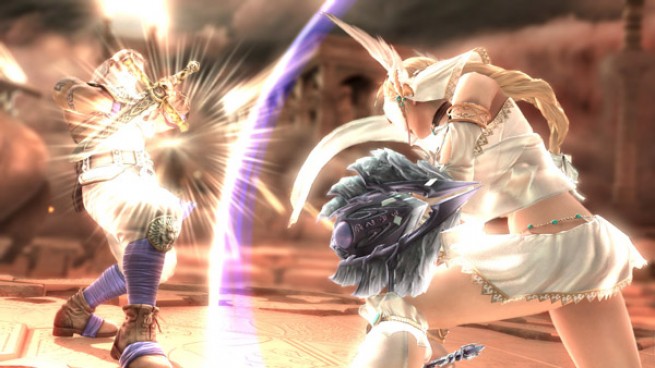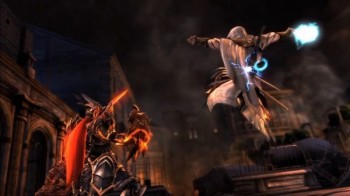Namco Bandai’s Soulcalibur returns to the crowded fighting-game genre with this fifth installment. The company originally wanted to focus on a new property after 2008’s Soulcalibur IV, but Producer Hisaharu Tago insisted that the franchise should continue. In order to revitalize the long-running series, Soulcalibur V moves its setting 17 years into the future and tweaks the weapon-based battles to appeal to a new generation of players. Now the question is whether the game will thrive in a market that is much more competitive than in its heyday.
This series has always impressed players with its flashy 3-D duels, detailed graphics, and involving content. Even with the time skip, the premise remains the same: Years after its supposed destruction, the cursed sword Soul Edge and its wielder, Nightmare, return to spread death and war across Europe. Knights, samurai, ninjas, lizardpeople, and an Elvis pirate travel the globe to either defeat Nightmare, claim Soul Blade for themselves, or find Soulcalibur, its opposing counterpart. The plot also focuses on the children of major character Sophitia, Patroklos and Pyrrha. The fighting is some of the best in the series, but the game falters in its handling of the single-player features that it excelled at before.
WHAT YOU’LL LIKE:
Fast, intuitive battles
Soulcalibur V is one of the easiest fighters to learn thanks to simple move commands that let you do multi-hit strings in no time. Each of the four buttons serves a specific purpose: horizontal swings cover a wide radius, vertical slashes deal more damage but are easier to sidestep, kicks are weak but fast, and guard defends against attacks. You better study though: Each warrior has around a hundred moves, each with different properties.
The franchise’s 8-Way Run system allows players to move freely around the battlefield to a greater degree than other 3D fighters. Footwork is important because you can corner opponents for a painful wall combo or toss them into the abyss for a ring out. Even in the new arena type similar to early Tekken games where the level has no boundaries, you need to stay in your weapon’s best range to succeed. Players criticized Soulcalibur IV for being slower than previous entries, so Namco added a Quick Step for faster dodges.
Meanwhile, the guard-break system will punish players for blocking too much. With enough blows, you’ll eventually crack your opponents’ defense and leave them open for an assault. Even with the more aggressive battles, however, a best-of-five round format gives you enough time to adapt to your opponent. A match between two experts is a give-and-take struggle to find an opening and gain better footing.

The Critical Gauge
This edition introduces a new special bar called a Critical Gauge to add some of the flash that competitors like Street Fighter have. Critical Edges are super combos that use one bar of the gauge for a powerful strike. Most are easy to combo into or have a special ability like being unblockable. Brave Edges strengthens certain attacks for the cost of half a bar. While they are weaker than Critical Edges, Brave Edges are more versatile and in some cases can lead to higher-damage combos.
Guard Impacts, a series staple that lets you repel incoming strikes, now also require half a meter, but you no longer have to guess whether the move will hit high or low. To compensate for this loss, the new Just Guard cuts down on the recovery time of a block if you guard at the precise moment the attack hits. Just Guards require strict timing and allow you to punish moves you normally couldn’t. Overall, the Critical Gauge adds extra strategy without overshadowing the overall gameplay.
Character variety
SC5 features a mix of veterans and brand-new warriors. While each weapon-user has a handful share of over-the-top moves, in practice they need to focus on fundamentals and cover their weaknesses. For example, rapier-specialist Raphael has great reach and speed, but he needs to press his adversary because his offense is linear and easy to dodge. Newcomer Natsu replaces series regular Taki, but the two share a similar playstyle: Get in close and slice foes apart with quick twin-blade cuts and surprisingly powerful ninja techniques.
The last game gave us the charge-move-based Hilde and the projectile-firing boss Algol, and SC5’s new characters continue a trend of unorthodox fighting styles. Z.W.E.I. can summon a werewolf apparition to keep the opponent busy while he makes his next move. The fortune teller Viola does weak damage, but her magic orb lets her pester her enemies from anywhere on screen.
Ezio from Ubisoft’s Assassin’s Creed joins the cast as a guest character, and is a straightforward combatant armed with a mid-range sword and stealth weapons like his crossbow. The Creation mode also lets your personalized fighter use the “Soul of Devil Jin” based on the Tekken fighter. This demon-powered martial art lets you dominate with the close-range combat and the deadly combos Soulcalibur’s sister series is known for.
The roster does have some omissions, and you’ll have to get downloadable content to play as the dastardly Dampierre. He has fun tricks in his repertoire, but many of them will randomly backfire on the troublemaker. Three of the characters are copycats who randomly use the movesets from the other cast members, but that doesn’t mean they’re taking the place of a unique duelist. The cast as it is gives players a diverse selection for fans of any skill level.
The online play of earlier Namco Bandai fighters suffered from horrible lag that made you feel like you were battling underwater. Netcode quality is the most-important feature to get right in a modern fighting game, and SC5 is on par with other popular titles like Super Street Fighter 4. You can still have a lousy frame rate that the game will occasionally drop matches if the connection is too bad, but overall the experience is smoother.
The new Soul Link feature shows your friend’s records in every mode at the menu screen, which is a nice inclusion. The Global Colosseo is a novel idea that lets you join massive lobbies based on region. Unfortunately, any section in the United States other than the New York and California areas are usually ghost towns.
Ever since Soulcalibur III, players have had the chance to create their own fighters from scratch and play as them online. Now you have more options than ever as you can apply patterns to your wardrobe and insert items that you can freely place along the entire model. I prefer using the given roster instead of creating my own, but this game gives you more customization options than any of its rivals.


